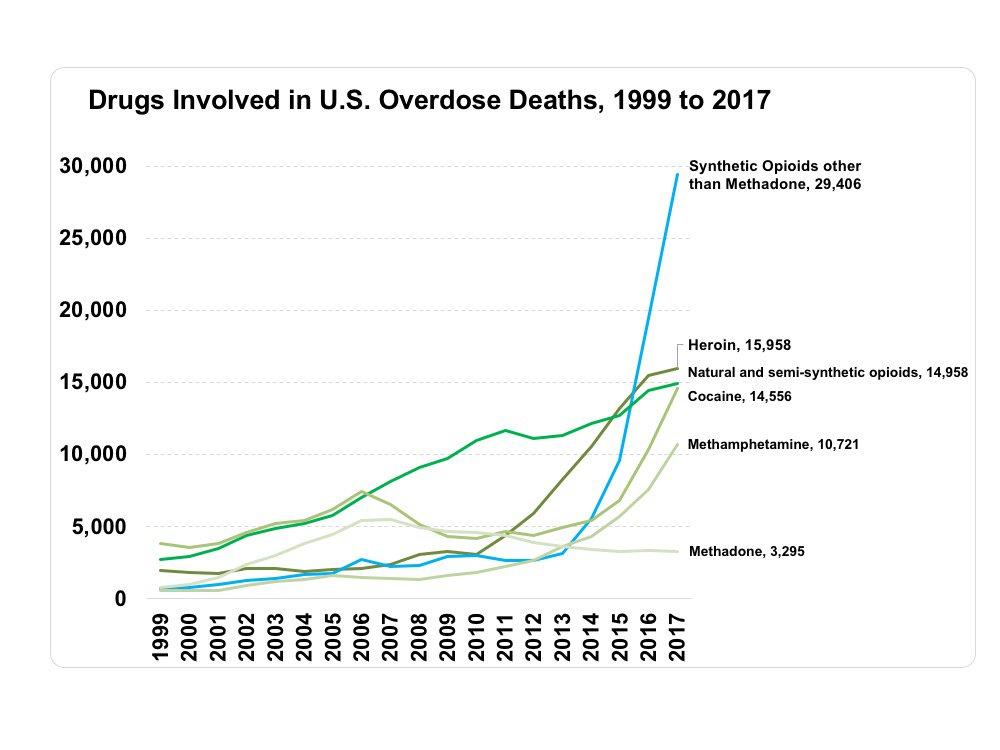Opioid Abusers Also Face Higher Risks Of Death From Suicide, Disease & Car Accidents
The surge in drug overdose deaths linked to powerful opioids like fentanyl and other analogues will likely be remembered as the defining national health crisis of the 2010s. And as the decade draws to a close, one study found that people who use illicit opioids face an increased risk of other "deaths of despair."
According to CNN, which cited findings from the study initially published Thursday in the medical journal JAMA Psychiatry (one of the more well-respected medical journals in the US) users of illicit opioids (i.e. everyone who uses them without a prescription) face an elevated risk of dying from noncommunicable diseases (like heart disease), infectious diseases and viruses (like HIV and Hep C), suicide and other unintentional injuries (like car accidents).
Suicide deaths among the sample group studied occurred at nearly 8x the expected rate, while unintentional injuries occurred at 7x the expected rate. Deaths from interpersonal violence, while still relatively infrequent, occurred at 9x the normal rate, which is also unsurprising. Heroin addicts will often take risks to get high, including trying to rob drug dealers, who often carry guns to ward off such attacks.
"People might be surprised that although overdose was the most common cause of death, it's far from the only cause of death that people using opioids outside a prescription experience at excessive rates," said Sarah Larney, lead author of the study and a senior research fellow at the University of New South Wales' National Drug and Alcohol Research Centre in Australia.
"Smoking-related illnesses such as cancer and cardiovascular diseases are common. Trauma is another major factor. People are exposed to car accidents, assaults and other causes of injuries at greater than usual rates, and suicide is also much more common than in the broader population," she said. "It's really clear that although overdose prevention is critical, we also need to look at the range of poor outcomes that people are experiencing, and work to reduce other causes of excess mortality such as suicide, chronic diseases and infectious diseases."
Researchers looked at opioid users across 28 countries, and compared their data to data collected from 124 previously published studies, some that were conducted as far back as Jan. 2009.
Unsurprisingly, researchers found that men faced significantly higher rates of drug-related deaths than women (unsurprising since the majority of hard-drug users are men). Older users also faced significantly higher rates of drug-related deaths.
But among women examined in the study, deaths from HIV were particularly pronounced. That's hardly surprising, since female heroin users will often work as prostitutes to raise money to finance their addictions. Men who consume excessive amounts of alcohol, meanwhile, registered much higher rates of deaths related to liver disease.
Overall, while poisoning- or substance-related deaths were the most common cause of death among opioid users (accounting for 31.5% of deaths), noncommunicable diseases accounted for 24.1% of deaths, while infectious diseases accounted for 19.7% and physical traumas accounted for 18.1%.
"To me the most important message to take from this study is that we need to think beyond the drug. People using opioids are people first and foremost, and have complex health and social needs," Larney said. "Making sure people have access to essential medicines to treat HIV and Hepatitis C; encouraging smoking cessation through access to nicotine replacement therapies; and ensuring access to nutritious food and safe shelter would all go towards reducing the death toll in this population."
A report issued in September by the US Congress Joint Economic Committee entitled "Long-Term Trends in Deaths of Despair" found that "mortality from deaths of despair far surpasses anything seen in America since the dawn of the 20th century...the recent increase has primarily been driven by an unprecedented epidemic of drug overdoses."
The explosion of opioid use and opioid-related deaths have been the primary drivers of a drop in overall life expectancy in the US for three straight years.
Most of those dying are relatively young white male adults.
https://ift.tt/2SzKJbZ
from ZeroHedge News https://ift.tt/2SzKJbZ
via IFTTT





0 comments
Post a Comment